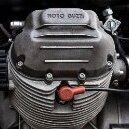
Meinolf
Members-
Posts
160 -
Joined
-
Last visited
-
Days Won
16
Meinolf last won the day on January 31
Meinolf had the most liked content!
About Meinolf
- Birthday 04/30/1959
Profile Information
-
Location
Germany
-
My bike(s)
Norge, V11, LM3, Mille GT, V1000G5+TR5 sidecar, 850 T5 Carabinieri, SPIII and assorted other makes
Meinolf's Achievements

Guzzisti (2/5)
212
Reputation
-
ANSWERED TPS break points at low throttle openings
Meinolf replied to audiomick's topic in Technical Topics
Hi Mick, no, 15mV tolerance is not sufficient. The total spread between the first breakpoints is ~20mV. Assuming you are off +15mV from 157mV would put the TPS well within the range of the next breakpoint; target missed. Even +/-10mV is stretching it thinly, +/-5mV is the highest tolerance I would go for. Cheers Meinolf -
ANSWERED TPS break points at low throttle openings
Meinolf replied to audiomick's topic in Technical Topics
Hi, if I understand your question correctly then the answer is easy. Looking at the first relevant voltage entries 0.176V - 0.157V - 0.137V the delta is 0.019V and 0.02V respectively, so the range is +/-0.02V for the inital entries. However, let's not forget that we are looking at millivolts here. I doubt that the average DMM has the accuracy and repeatability to operate reliably in the millivolt and below range. Test lead resistance, tolerances of the ADC, accuracy of the 5V supply to the TPS and the general operation of an ADC came into play. Cheers Meinolf -
ANSWERED TPS break points at low throttle openings
Meinolf replied to audiomick's topic in Technical Topics
Hi, as to the question why more TPS breakpoints are used in the low range than in the upper. It's about flow area increase when the butterfly valve is opened. The flow area resulting from the movement is based on a rather complicated cosine formula, several years ago Beard kindly wrote a small program to simplify the calculation. Looking at the 1st (TPS degree) and 4th column (free flow area in mm^2 including the butterfly axle diameter) one can derive the change in %. 7.7/5.2=1.46=46% increase 22.0/20.0=1,1=10% increase So, ~2.3 TPS degree change at low throttle opening result in 46% flow area increase, a 2.0 TPS degree change in mid range is 10% flow area. It makes sense to use TPS breakpoints which provide the a like flow area increase. Cheers Meinolf -
ANSWERED TPS break points at low throttle openings
Meinolf replied to audiomick's topic in Technical Topics
Hi, it didn't take that much time. The 157mV instead of 150mV is simply based on a rounding error in the OEM TPS lookup table. 5V/255=0,01953V 8x0,01953= 0,1563V=156,3mV Now one may argue if the 6,3mV difference is significant. No, it isn't. But why use a wrong value if the correct one is known. Cheers Meinolf -
ANSWERED Acceleration Enrichment Map-2004 Rosso Corsa
Meinolf replied to Rob NZ's topic in Technical Topics
Hi, as rightly pointed out the 15M has neither the internal connection from the Lambda voltage signal pin to the PCB nor the code neccessary to process the signal if it were to arrive. And the RC code can't be uploaded to the 15M w/o bricking it. But, the real problem lies elsewhere. The V11 engine was not designed with a Lambda of 1 as permanent value over a range of rpm/TPS in mind. It runs quite well with Lambda 1, but even slight changes to 1.03 are instantly and clearly noticeable. Not favorably, mind. The CARC models in contrast work well and one doesn't notice the same degradation. During my tests I oftentimes had entire regions of Lambda exceeding 1.1 without even noticing it, only the logged data did show it. So, upgrading to closed loop absolutely requires a cylinder selective tuning of the fuel values to achieve a synchronized Lambda no higher than 1 on both cylinders. Which in my case extended over many months of datalogging and analysis. Also consider the reason why a constant Lambda 1 and there closed loop operations were introduced before starting this journey. Emission control was the driver. The catalysator works best at 1 and has the highest conversion rate. If the cylinders are selectively tuned anyway to allow a closed loop operation, then closed loop is not required and the catalysator isn't there anyway. Cheers Meinolf -
ANSWERED Acceleration Enrichment Map-2004 Rosso Corsa
Meinolf replied to Rob NZ's topic in Technical Topics
Hi, I fully agree with above. The main issue with the OEM BINs and their fuel values is the lacking synchronisation of the lambda (AFR) values between the 2 cylinders. If lambda is different between the cylinders at a given operating point the engine will not run as smoothly and efficient as it could in non-closed loop mode. If it's in closed loop the slow OEM lambda probe excerbates the discontent as differing lambda values are reported to the ECU from one combustion cycle to the next. It goes crazy trying to cancel out countermanding values. Evening out the lambda values between the cylinders at any given breakpoints will achieve 95% of what can reasonably be achieved. Everything else is cream on top. And as the time needed for either is inverse (5% getting the lambda synchronity right/95% to for the rest), Plus, this approach fits best to the OEM ignition values. I have no means of checking them, but guess/hope that Mandello knew better/had the required setup, to get these right. Cheers Meinolf -
ANSWERED Acceleration Enrichment Map-2004 Rosso Corsa
Meinolf replied to Rob NZ's topic in Technical Topics
Hi, Ok, some nitpicking from my side. The ADC does read smaller values. The way the correlation between TPS ADC values and TPS degree values works is that the ADC value is used to select a corresponding TPS degree value in the TPS Lookup Table, TPS ADC -> TPS degree. I assume that the lowest ADC values are not used in the TPS Lookup table (0 values) as they are reserved for the error detection of the TPS signal. Cheers Meinolf -
ANSWERED Acceleration Enrichment Map-2004 Rosso Corsa
Meinolf replied to Rob NZ's topic in Technical Topics
Hi, indeed the accel fuel map doesn't make a lot of sense. Consider the following. The accel function is only used if a TPS opening/closing treshold speed is exceeded. Quickly opening the throttle will lead to an main fuel value from the main fuel table which is larger than the one beginning with while the rpm remains unchanged for a a relatively long time. Which in turn means that the air mass (and its speed) moving to the combustion chamber will not change as rapidly. The result is an increased fuel injection time while the air mass remains largely unchanged. Ipso, the mixture will enrich w/o any support from the accel enrichment map. And the accel enrichment tapers out with increasing rpm anyway. Instead of meddling with the accel fuel enrichment changing the ignition values makes much more sense. A richer mixture needs less time to ignite, hence reducing the ignition advance while accelerating to move (or keep) the max. combustion pressure closer to TDC + ~12-15° is the way to go. Cheers Meinolf -
ANSWERED Acceleration Enrichment Map-2004 Rosso Corsa
Meinolf replied to Rob NZ's topic in Technical Topics
Hi Rob, the accel enrichment map is used also in closed loop operation if the opening/closing speed of the TPS exceeds threshold values. Cheers Meinolf -
My Scura has acquired a cough - post TPS adjustment
Meinolf replied to PJPR01's topic in Technical Topics
Hi, 350mV is in the range you would see if the TPS is not fully closed. If it ran well with this setting and not so after changing to 157mV then my guess is that you did not remove all the stops keeping the TPS from being fully closed. Much success in resolving the bug. Cheers Meinolf -
Hi, The ECU switches to communications mode when GuzziDiag or the reader/writer programs connect and the fuel pump will not spin up. If the fuel pump spins then GuzziDiag or the reader/writer programs don't connect to the ECU. Two likely reasons, either the connector/adapter is the wrong one or defective or the plus/minus cables are not connectd. Or, in case of the reader/writer, the programs are not the ones to be used with your ECU. Have you tried connecting GuzziDiag successfully? If yes, which ECU did you select? Are you using the reader/writer for this ECU? Cheers Meinolf
-
Hi, I haven't seen an answer to your question. The bypass screw increase air flow thru the bypass when opened and vice versa. Which takes care of the air mass portion in idle and a bit above. The CO trim in/decreases fuel in idle and up to 3k rpm, which is the 2nd part of the AFR equation. Some might remember that my BINs are based on completely closed bypass screws and 0 CO trim, the required AFR adjustment was done via fuel injection values instead. Cheers Meinolf
-
Hi Cam/Sporti Coils wondering if Stick Coils Feasible?
Meinolf replied to Weegie's topic in Technical Topics
Hi John, the procedure as I understand it is as follows. The ECU goes thru an initial process to determine the engines rotational status. Eg, which cylinder is where and in which state, compression or emptying the bucket. This is governed by the toothed wheel attached to the camshaft and the engine position sensor and takes several engine rotations. After the status has been established and verified the fuel phase table takes over. This table contains rotational degree values which are the starting point for the calculation of coil discharge and injector opening time. They are used in a backward calculation. Which makes sense if one considers that the behaviour of any coil is depended on voltage (and coil design characteristics) and the logarithmic charging characteristics. So the tooth wheel and the missing teeth provide the starting point for the capcom-ops in the code which do the pulse-counting. This starting point (from a rotational point of view it's behind TDC) is in fact the point at which the circuits are opened again. Meaning, the point at which the discharge of the coil or the opening of the injector end. So the calc looks like this: Endpoint (fuel phase table value) + coil charging time/injector opening time = coil discharge start/injector opening The code also contains a trim table to take care of the voltage dependencies. Eg, lower voltage requires a longer coil charging time/injector opening time to achieve the same effect due to the slower coil saturation. So, the answer to your question "Does the ECU vary the period it opens" is yes, it does. Based on the terrific analysis of the components used in the 5AM ECU done by John Th. we know that the current draw is used as another factor in the 5AM (and presumably later generations). I don't know if this current draw was already used in the 15M/RC. Cheers Meinolf -
Hi Cam/Sporti Coils wondering if Stick Coils Feasible?
Meinolf replied to Weegie's topic in Technical Topics
Hi John, I can probably contribute something, but need to know which ECU you are referring to. Cheers Meinolf -
ANSWERED My Stelvio coughs on overrun and does not like idling!
Meinolf replied to LangleyMalc's topic in Newer models
Hi Pete, Thanks for the excellent explanation, very well done. Meinolf- 44 replies
-
- carburation
- lambda sensor
-
(and 1 more)
Tagged with:





